| 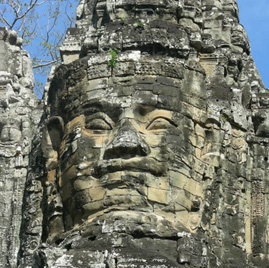
 Karen's Perspective on Traveling
Alone Karen's Perspective on Traveling
Alone






















|
Grand Lake and Rocky Mountain National Park
As I lay next to the warm fire in the great room of Shadowcliff Lodge in Grand Lake, CO, listening
to a staff member sing and play an original song on his guitar, I knew I had found someplace
special, the kind of refuge that creates the best travel memories. Shadowcliff is a dream and a
vision made real by a couple who came to CO and staked their claim in the 50's along the raging
Colorado river as it pours out into Grand Lake and beyond to Granby Lake. The mostly volunteer
result is a prime location with property that practically abuts Rocky Mountain National Park. One of
the young staff told me she had gone on a hike in the previous week and came across a female moose
and her young offspring. Ashley, from the Midwest, had never seen a moose or anything remotely like
it, and thought she would likely die. Instead the female moose moved on and Ashley had a good story
to tell as well as the excitement of knowing that wilderness still reigns in CO.
Santa Fe and Mesa Verde
I lay in front of the circular fire with its recessed benches and became drowsy with the pleasant
tiredness of the last 5 days of driving and adventures. I had started my road trip in Lubbock, TX,
making it across the vast West Texas dust ridden towns of Littlefield, Muleshoe and Clovis to the
stunning and artsy town of Santa Fe. I stayed in a delightful airbnb that kept its front door
unlocked and opened to a screen door at night. Dinner in the patio at one of the attractive
restaurants off the historic plaza was a hearty corn chowder. For many summers while I was growing
up my mom had driven my sister and I to visit my great grandmother who lived in Denver. And members
of my extended family had owned part of a condo in Frisco for maybe 30 years. The last time I had
been to CO though was in 2008, when I spent the last days of the presidential race helping Obama
turn the state blue by going to door to door in Denver. But I had never actually toured the state in
my own style. A family wedding in Denver gave me the impetus to revisit the state and try to uncover
why my maternal ancestors were drawn there.
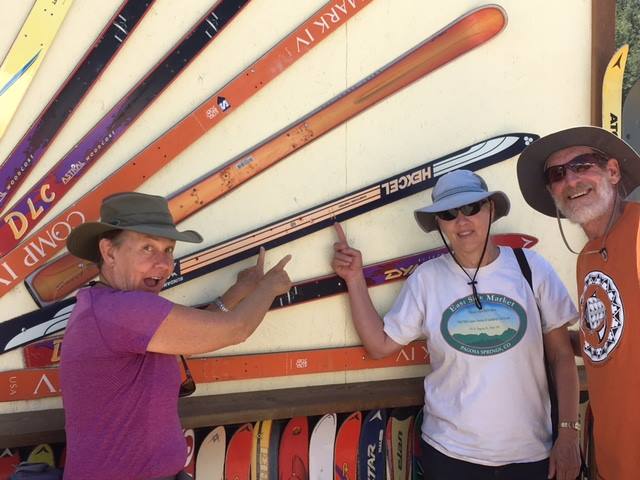 From Santa Fe I got an early start to arrive at Mesa Verde National Park which I had visited on a
road trip exactly 36 years previously, in June of 1981 when a group of my girlfriends and I took a
trip out west after graduating from college in North Carolina. The drive from Santa Fe to the park
was delightful, especially the verdant valley south of Pagosa Springs where I turned west to drive
through Durango and then on to Mesa Verde, arriving in time to sign up for a 5pm Balcony House tour,
the most physically challenging of the public tours. Balcony House and all of Mesa Verde was of
course the center of life for Pueblo Native Americans. The Mesa Verdeans survived using a
combination of hunting, gathering, and subsistence farming of crops such as corn, beans, and squash.
They built the mesa's first pueblos sometime after 650, and by the end of the 12th century, they
began to construct the massive cliff dwellings for which the park is best known. By 1285, following
a period of social and environmental instability driven by a series of severe and prolonged
droughts, they abandoned the area and moved south to locations in Arizona and New Mexico. We
observed the tiny springs under the sandstone where they gathered water still providing sustenance
and a few pinyon pine trees with their nutritious pine nuts. And yes we had to climb the vertiginous
ladders up 30 feet to be able to access the Balcony House with its magnificent views of the
surrounding plains.
From Santa Fe I got an early start to arrive at Mesa Verde National Park which I had visited on a
road trip exactly 36 years previously, in June of 1981 when a group of my girlfriends and I took a
trip out west after graduating from college in North Carolina. The drive from Santa Fe to the park
was delightful, especially the verdant valley south of Pagosa Springs where I turned west to drive
through Durango and then on to Mesa Verde, arriving in time to sign up for a 5pm Balcony House tour,
the most physically challenging of the public tours. Balcony House and all of Mesa Verde was of
course the center of life for Pueblo Native Americans. The Mesa Verdeans survived using a
combination of hunting, gathering, and subsistence farming of crops such as corn, beans, and squash.
They built the mesa's first pueblos sometime after 650, and by the end of the 12th century, they
began to construct the massive cliff dwellings for which the park is best known. By 1285, following
a period of social and environmental instability driven by a series of severe and prolonged
droughts, they abandoned the area and moved south to locations in Arizona and New Mexico. We
observed the tiny springs under the sandstone where they gathered water still providing sustenance
and a few pinyon pine trees with their nutritious pine nuts. And yes we had to climb the vertiginous
ladders up 30 feet to be able to access the Balcony House with its magnificent views of the
surrounding plains.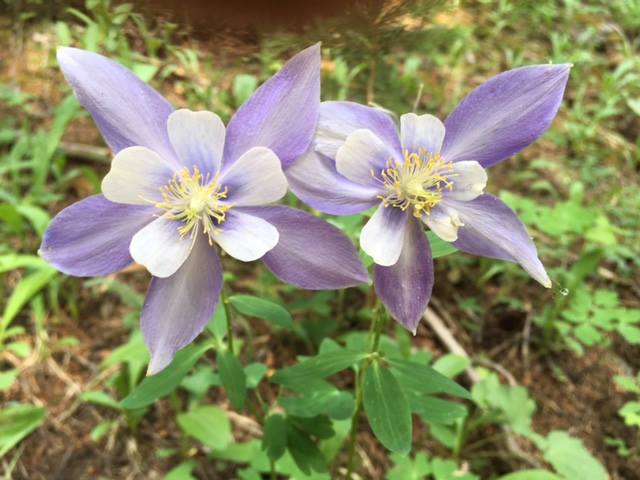
The temperature dropped quickly after dark as I settled into my first night of camping. I had easily
found a site with no reservation (as Lonely Planet promised), but my, the ground was hard, even with
my thermarest. Maybe camping on a bed at Kalani on the Big Island had spoiled me or maybe I was just
getting old and soft. Either way, I was awakened by birds in the early morning and stretched my achy
joints. I needed to make an early start anyway as I had a 9:30am reservation to ride the bus from
Durango to Silverton and then take the famous steam train back. On the way out of the park, I
stopped my car at a sunny overlook, pulled out my camp stove and chair and made myself a quick
breakfast. Ah the joys of traveling alone with miles and miles of gorgeous landscape laid out in
front of me like an endless banquet. Wildflowers were blooming and the feeling of just starting an
adventure quickened my pulse. With the challenges of family members dying the last 6 months, I was
determined to experience every moment to its fullest.
Silverton to Durango, Telluride and Grand Lake
The steam train and buses from Durango to Silverton are the lifeblood of both communities and I was
thankful that I had chosen to go one way on the bus, thereby cutting down on the trip by at least 1
1/2 hours. I was also able to see it from a different perspective as the train mostly follows the
Animas River until it slowly climbs up to reach Durango while the bus goes over a couple of
stupendous mountain passes. This car route is of course the renowned "million dollar highway," so
named because it was estimated to cost a million dollars per mile when it was constructed. It was
completed in 1924, and today the entire route is part of the San Juan Skyway Scenic Byway. After
arriving in Silverton I quickly joined a tour that was going to visit a defunct mine as I didn't
want to just eat and shop in town while I waited for my return train. The mining tour was
educational and fun as we donned rain jackets and hard hats and made our way into an old mine inside
the historical ore cars that ran along tracks. Our tour guide had actually worked in a mine and was
able to show us the various methods used to extract the ore, including how dynamite was positioned
to blow up the veins. 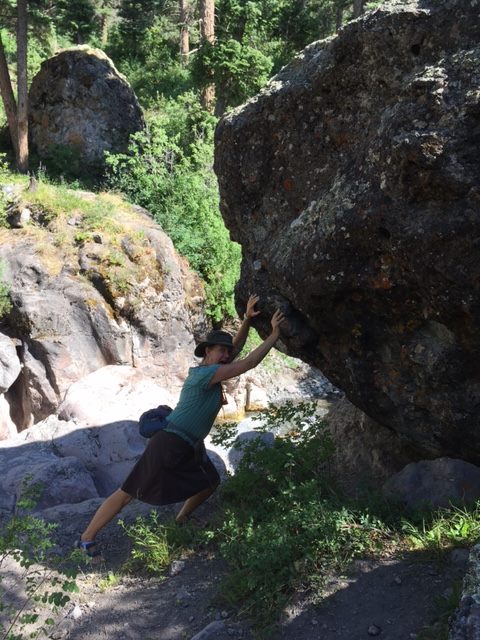 He explained the various hazards associated with the industry including the
fine particulates that accumulated in the lungs of the miners from mining copper, silver and gold.
His hearing aides gave testimony to the fact that the work was ear shattering. I had missed my 1:45
train back but no bother as I caught the next train at 2:30pm. The trains have a a range of cars
from the domed and somewhat luxurious to the simple enclosed bench seats where I enjoyed seeing the
raging Animas River. Along the way, we saw three kayakers pulled off to a bank and I wondered how
they could run these rapids at this spring runoff. Later we picked up several backpackers and I
learned that the trains make flagstops at two locations along the way. I chatted with the
backpackers and they had to abandon some of their week's route as there was too much snow in the
high country to continue without skis or snowshoes. He explained the various hazards associated with the industry including the
fine particulates that accumulated in the lungs of the miners from mining copper, silver and gold.
His hearing aides gave testimony to the fact that the work was ear shattering. I had missed my 1:45
train back but no bother as I caught the next train at 2:30pm. The trains have a a range of cars
from the domed and somewhat luxurious to the simple enclosed bench seats where I enjoyed seeing the
raging Animas River. Along the way, we saw three kayakers pulled off to a bank and I wondered how
they could run these rapids at this spring runoff. Later we picked up several backpackers and I
learned that the trains make flagstops at two locations along the way. I chatted with the
backpackers and they had to abandon some of their week's route as there was too much snow in the
high country to continue without skis or snowshoes.
After I arrived back in Durango, I jumped into my car and drove a couple of hours to reach
Telluride, certainly one of the loveliest box canyons in the country. On the way, I managed to see
elk at dusk in the large meadows along the route. I stayed in a hotel that cost almost $200 as
Telluride is a tiny town with its gondola that runs until midnight, taking tourists and locals up to
the ski resort and a large residential area full of condos as well. The next morning I drove to the
end of town to see a striking waterfall as well as the huge meadows where the almost weekly summer
music festivals are held. Folks were gearing up for the Telluride Folk Festival as I headed north.
Today would be the granddaddy of all road trips as I had a reservation at Shadowcliff Lodge in Grand
Lake. To get there would take almost 10 hours including a couple of stops. Starting at Grand
Junction, I followed Highway 70 and the Colorado River east, stopping in Palisade to pick peaches
off a tree at a bank parking lot and then having lunch along the banks of the Colorado. It was
mesmerizing to keep following the Colorado into Glenwood Springs and then out along Highway 70. But
it became even crazier when I turned north onto county road 1 where the road became a dirt one for
at least 30 miles, climbing higher and higher above the Colorado River. It was stunning but suddenly
I saw almost no other cars except for a few jeeps or trucks full of raft gear. My gas gage was at
1/4 of a tank and I wondered if I had been a fool not to fill up. But finally I saw the signs for
Kremmling and knew I was fine. Another couple of hours and I was enjoying a salmon steak and green
beans along the boardwalk of Grand Lake, perhaps the most visually stunning town on my trip.
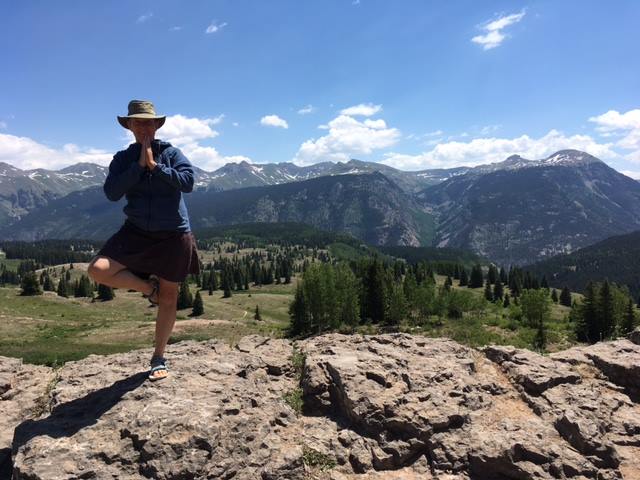 I rested the next day of the trip, inviting Ashley, a young woman who was working at Shadowcliff to
join me for a few hours at Hot Sulphur Springs, the first of many hot springs and competing with
Orvis for the top prize. And what makes for an excellent hot springs experience? First, I enjoy
having some choices of water temperatures and views to choose from. Also, the mineral content of the
waters themselves is always intriguing. What made these springs so excellent was also the chaise
lounge chairs in the shade and the quiet of some pools combined with the social nature of others.
The only downside was the required swimsuit. I took a short hike out to some small falls and also a
lovely alpine meadow before heading into town to enjoy another meal with views of Grand Lake.
Driving through Rocky Mountain National Park along Trail Ridge Road is quite an experience as you
get above tree line pretty quick and feel the desolation, wind and cold of the high country of the
alpine tundra, over 1/3 of the park area. I was meeting my friend Scott whom I had met the previous
summer in Alaska on the ferry to Kodiak. Scott lives in Boulder, knows the park well, and suggested
we hike in the Bear Lake area. The park was more crowded that Friday than he said he had ever seen
it but we lucked out with a parking space at the trailhead. The hike out to Sprague Lake was popular
but gorgeous and we got some snow along the upper elevations. I made my way from there into Denver
and the temperatures rose into the 90's. The next few days were spent with all my cousins, sister
and her family as we celebrated a family wedding. Visiting the Botanical Garden with its Calder
exhibit was impressive, its cool waters and green in the middle of the city a welcome reprieve from
the heat.
I rested the next day of the trip, inviting Ashley, a young woman who was working at Shadowcliff to
join me for a few hours at Hot Sulphur Springs, the first of many hot springs and competing with
Orvis for the top prize. And what makes for an excellent hot springs experience? First, I enjoy
having some choices of water temperatures and views to choose from. Also, the mineral content of the
waters themselves is always intriguing. What made these springs so excellent was also the chaise
lounge chairs in the shade and the quiet of some pools combined with the social nature of others.
The only downside was the required swimsuit. I took a short hike out to some small falls and also a
lovely alpine meadow before heading into town to enjoy another meal with views of Grand Lake.
Driving through Rocky Mountain National Park along Trail Ridge Road is quite an experience as you
get above tree line pretty quick and feel the desolation, wind and cold of the high country of the
alpine tundra, over 1/3 of the park area. I was meeting my friend Scott whom I had met the previous
summer in Alaska on the ferry to Kodiak. Scott lives in Boulder, knows the park well, and suggested
we hike in the Bear Lake area. The park was more crowded that Friday than he said he had ever seen
it but we lucked out with a parking space at the trailhead. The hike out to Sprague Lake was popular
but gorgeous and we got some snow along the upper elevations. I made my way from there into Denver
and the temperatures rose into the 90's. The next few days were spent with all my cousins, sister
and her family as we celebrated a family wedding. Visiting the Botanical Garden with its Calder
exhibit was impressive, its cool waters and green in the middle of the city a welcome reprieve from
the heat.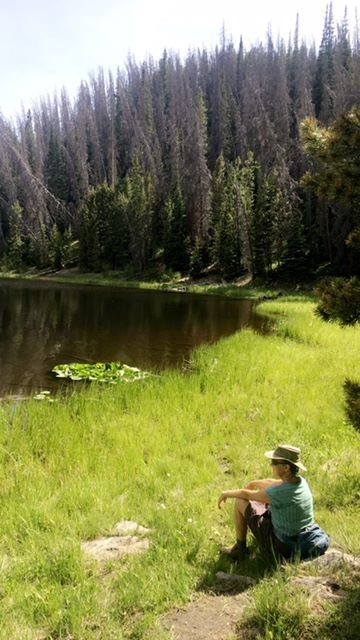
Silverthorne and Lake Dillon
My nephew Wyatt and I left Denver and headed to the High Rockies area of Silverthorne where I had rented a condo for the night. We enjoyed walking around Lake Dillon at
dusk and had the most unusual sighting in Silverthorne when a red fox (apparently these are the
species of fox even though it appeared gray) walked across the road in front of us with a white
sphere in its mouth. Wyatt caught the whole thing on video, including me exclaiming that it looked
all the world like a white tennis ball but indeed it must have been a very large goose egg? Nature
can be so wonderfully surprising sometimes. The next day we rented bikes and rode around the world
class, 18 mile bike path that circles Lake Dillon, a man made but gorgeous lake that is a reservoir
for Denver. At a few points the grade reached 10% and I could certainly feel the altitude. The path
climbs over Swan Mountain and reaches its highest elevation of 9,500' at the top at Sapphire Point,
which is 1,100' above the lowest point of the bike path. The path dissolves into the road on the
other side and you have to share the road with some cars but then it picks up again outside of
Frisco and becomes car free again. Wyatt and I stopped for a welcome lunch in downtown Frisco and
reminisced about various ski trips we had enjoyed in the area. We made it back in time to drop him
at the Denver airport and I spent the night with cousins as my new adventure buddies Meri and John's
flight had arrived late. We waited until the next morning to rent our RV and head back to Lake
Dillon where they rented road bikes to do the Lake Dillon circuit in about 2 hours, cutting off a
good hour from the time Wyatt and I had taken.
 I had met Meri and John when they were on sabbatical at Kalani Retreat Center on the Big Island and
they were also in CO to go to a family wedding. They had planned to rent a 22' Minnie Winnie so I
decided to go along for the "ride." We often remarked that we used to make fun of the old farts who
rented RV's but now we were enjoying its conveniences like a fridge and toilet. We enjoyed a
cocktail at the tiki bar on the shores of the lake, close to its marina, then headed into Frisco for
some delicious sushi at Kemosabe Sushi, sitting outside along Main Street and enjoying the pleasant
weather after a few sprinkles. We camped at Peak One campground and I slept outside in my cozy tent,
enjoying a paco pad, a very thick sleeping pad made for white water camping, that I had borrowed
from my cousins. The views of Peak One which rises up to almost 13,000' were stunning and the
campground was surprisingly quiet and tranquil.
I had met Meri and John when they were on sabbatical at Kalani Retreat Center on the Big Island and
they were also in CO to go to a family wedding. They had planned to rent a 22' Minnie Winnie so I
decided to go along for the "ride." We often remarked that we used to make fun of the old farts who
rented RV's but now we were enjoying its conveniences like a fridge and toilet. We enjoyed a
cocktail at the tiki bar on the shores of the lake, close to its marina, then headed into Frisco for
some delicious sushi at Kemosabe Sushi, sitting outside along Main Street and enjoying the pleasant
weather after a few sprinkles. We camped at Peak One campground and I slept outside in my cozy tent,
enjoying a paco pad, a very thick sleeping pad made for white water camping, that I had borrowed
from my cousins. The views of Peak One which rises up to almost 13,000' were stunning and the
campground was surprisingly quiet and tranquil.
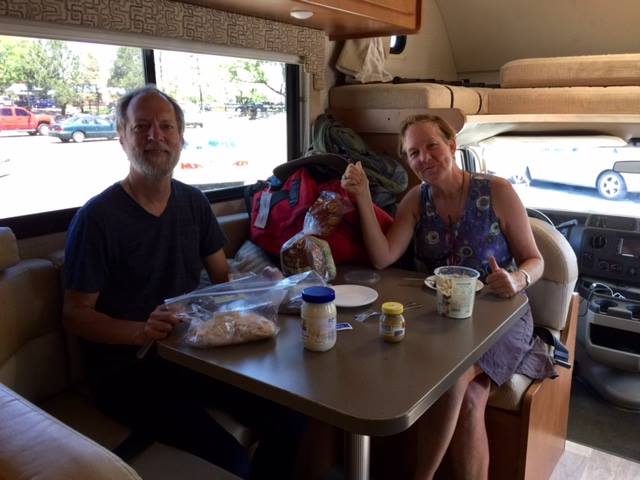
Breckenridge, Alma and Buena Vista
Outside of Breckenridge we agreed on McCullough Gulch, which is a
rather uninspiring name for such a quintessential Rockies trail along the Blue River that feeds into
Lake Dillon. This 2.9-mile roundtrip hike meanders through evergreen forests, past waterfalls,
meadows, and wildflowers, especially some lovely yellow and blue columbine, the state flower. After
we made it to a favorite lunch spot over looking some falls, John and Meri decided to go further up
where there was snow. I waited for them where I was but soon heard thunder and felt a few sprinkles
so decided to head back down in case we were about to experience a thunderstorm. On the way down, I
met a young man who was recovering from a fright since he had been alone and had fallen and taken a
bit of a spill in the snow. We headed south through Alma, CO where according to family lore, my
great uncle Napolean "Scotty" Gow had been the town drunk and pool shark. I had visited Scottie with
my mom and sister when I was a girl and vividly remember his small trailer stuffed with National
Geographics where he lived year round. Alma was a super small town that had seen better days but it
did have the highest marijuana dispensary in the country called High Country Healing so we stopped
so my cohorts could buy some edibles. I asked a local in the dispensary about the old bar where my
relation Scotty might have hung out back in the day or if there were any old timers I could chat
with. He directed me to the museum down the road in nearby Fairplay where I did meet a woman who had
lived in Alma for 40 years and who knew Scotty by reputation as her husband was a surveyor who used
to drink with him. When I mentioned that I had known him to be the town drunk, she laughed and said
that appellation was shared by many men in the town. I called my sis to let her know what I had
found out and she reminded me that she had visited his tombstone on a trip to Alma about 20 years
previously so I'll have to go back sometime and check that out.
We made it to Buena Vista and decided to have a soak at Cottonwood Hot Springs that evening which
was not the most aesthetically pleasing hot springs. But I decided to forego the camping and stayed
in an inexpensive and lovely room at the springs. We had a pretty early start the next day as we had
signed up to raft Brown's Canyon on the Arkansas River. The river was running at 3500 cubic feet per
second and the spring runoff had just peaked so we had a lively and thrilling class 3 run which
became even more exciting and a bit scary when one of our party fell out of the raft and took a
swim. As the current was strong he seemed to be caught in the current for at least 5 minutes or so
before he could catch an eddy. I have swum myself on both the Snake and American rivers so I was
glad it was him and not me. Apparently Brown's Canyon is the most rafted river of any stretch in the
United States.
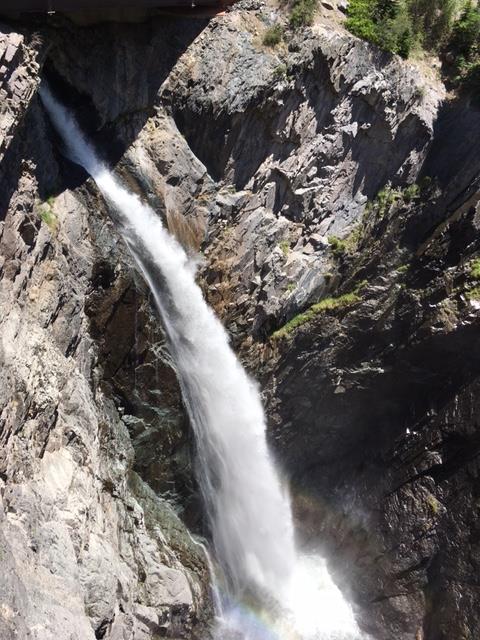 Pagosa Springs and Ridgeway
Pagosa Springs and Ridgeway
My cousin Jan who lives in Pagosa Springs picked me about halfway
between Pagosa and Buena Vista and took me to the gorgeous house she and my cousin Jeff built about
5 miles outside town. To get to Pagosa, we went through a large valley where lots of potatoes are
grown and over the exquisite Wolf Creek Pass which has the distinction of having the most powder of
any ski resort in CO. Pagosa, a Ute term for 'boiling water,' refers to the other local draw: hot
springs. Natural thermals provide heat for some of the town's 1900 residents. On summer weekends my
cousin Jeff runs a craft and food market next to the Eastside Farmer's Market so we enjoyed its laid
back ambience before Jan, her friend Kristeen and I rigged up what they call "fat cats," single
person pontoon rafts. We put in near their house and rafted about 7 miles to downtown, with the
water level on the San Juan about at the low edge of being navigable. I enjoyed steering my own
pontoon and was comfortable with these pretty tame rapids. But the next day I was happy to be in
Jeff's raft as we started out again in downtown and made our way about 15 miles downstream through
Mesa Canyon. The temperature was perfect in the low 80's and we saw quite a few golden eagles
circling above as well an osprey in a tree. Meri and John arrived in the RV the next day and we
dropped off John to go on a horseback ride while Meri got a massage after a nice lunch at the Pagosa
Bakery. We made our way to Pagosa's Hot Springs, with glorious pools along the San Juan River. They
have healing, mineral-rich waters from the Great Pagosa Aquifer, the largest and deepest hot mineral
spring in the world. Man-made pools look fairly natural, and the views are of folks rafting and
swimming along the river where we had rafted the day before. Also, it's the only hot springs I have
ever been to with pool-side drink service, so we ordered up some smoothies.
I was a bit sad to leave my cousins and the good times we had in Pagosa but we headed west to
Durango, retracing the route I had taken along the Million Dollar Highway to Silverton and then up
to famous Ouray, stopping along the way at the jaw dropping Bear Creek Falls. In Ouray we started
with a hike along the Perimeter Trail but aborted that after a couple of miles because of the heat
and sunbaked trail. We found a better trail that still intersected the perimeter trail called Baby's
Bath that ran along a creek. Our main goal now was to find a campsite at Ridgeway State Park, have a
great Thai dinner in Ridgeway and still have plenty of time at Orvis Hot Springs, the absolute gem
of all hot springs I visited in CO. The peaceful and secluded grounds are like Eden with their
thoughtful and luscious landscaping. Everything is aesthetically pleasing and 4 pools are of
different temperatures with one very large pool a perfect lounging temperature. It even had cold
droplets you could let drip on your back. And best of all, this hot springs is clothing optional
with a chill vibe for couples and singles. The backdrop of the Rockies at sunset was phenomenal and
this hot springs certainly lived up to its reputation with locals I had queried.
Black Canyon of the Gunnison
We drove from Ridgeway past the unattractive town of Montrose with its box stores to reach perhaps
the most extraordinary National Park on the trip, mostly because its grandeur was unexpected. I had
never even heard of the Black Canyon of the Gunnison before preparing for the trip by downloading
Lonely Planet's book on Colorado. The National Park service describes the canyon as "Big enough to
be overwhelming, still intimate enough to feel the pulse of time, Black Canyon of the Gunnison
exposes you to some of the steepest cliffs, oldest rock, and craggiest spires in North America. With
two million years to work, the Gunnison River, along with the forces of weathering, has sculpted
this vertical wilderness of rock, water, and sky." We walked along the south rim as the hike to the
bottom of the canyon required a permit and is on unmaintained trails.
 The metamorphic rock that dominates the walls of the Black Canyon is called gneiss (pronounced
"nice"), and is blended with schist, another rock that normally has flat or elongated crystals. I
especially enjoyed our RV tour of the various panoramic turnouts along the south rim for a couple of
hours until sunset. I had learned how to identify a few types of rocks last year on a rafting trip
down the Grand Canyon, mainly vishnu schist and Bright Angel shale. The walls here seemed just as
complicated in their makeup. We again saw at least 5 or 6 golden eagles and I couldn't help
wondering if there might also be a condor or two but apparently there was only ever one sighting of
an accidental CA condor in the park. We valiantly tried taking sunset photos and a few managed to
capture the magnitude of the canyon with its ribbon of the Gunnison River deep deep below. And like
the exploration of the Grand Canyon, early explorers here used heroic means to reach its depths. One
entrepreneur even succeeded building a railroad through parts of the canyon. Rudyard Kipling
described his 1889 ride through the canyon in the following words: "We entered a gorge, remote from
the sun, where the rocks were two thousand feet sheer, and where a rock splintered river roared and
howled ten feet below a track which seemed to have been built on the simple principle of dropping
miscellaneous dirt into the river and pinning a few rails a-top. There was a glory and a wonder and
a mystery about the mad ride, which I felt keenly..." The canyon is named for Captain John Williams
Gunnison who provided the first official account of its existence although of course the Ute Indians
knew of its existence. Gunnison and seven of his men were killed by the Ute, although there is some
controversy that the killing was actually done at the bidding of the Mormons and Brigham Young.
Either way, Gunnison was at the wrong place at the wrong time and he paid dearly.
The metamorphic rock that dominates the walls of the Black Canyon is called gneiss (pronounced
"nice"), and is blended with schist, another rock that normally has flat or elongated crystals. I
especially enjoyed our RV tour of the various panoramic turnouts along the south rim for a couple of
hours until sunset. I had learned how to identify a few types of rocks last year on a rafting trip
down the Grand Canyon, mainly vishnu schist and Bright Angel shale. The walls here seemed just as
complicated in their makeup. We again saw at least 5 or 6 golden eagles and I couldn't help
wondering if there might also be a condor or two but apparently there was only ever one sighting of
an accidental CA condor in the park. We valiantly tried taking sunset photos and a few managed to
capture the magnitude of the canyon with its ribbon of the Gunnison River deep deep below. And like
the exploration of the Grand Canyon, early explorers here used heroic means to reach its depths. One
entrepreneur even succeeded building a railroad through parts of the canyon. Rudyard Kipling
described his 1889 ride through the canyon in the following words: "We entered a gorge, remote from
the sun, where the rocks were two thousand feet sheer, and where a rock splintered river roared and
howled ten feet below a track which seemed to have been built on the simple principle of dropping
miscellaneous dirt into the river and pinning a few rails a-top. There was a glory and a wonder and
a mystery about the mad ride, which I felt keenly..." The canyon is named for Captain John Williams
Gunnison who provided the first official account of its existence although of course the Ute Indians
knew of its existence. Gunnison and seven of his men were killed by the Ute, although there is some
controversy that the killing was actually done at the bidding of the Mormons and Brigham Young.
Either way, Gunnison was at the wrong place at the wrong time and he paid dearly.
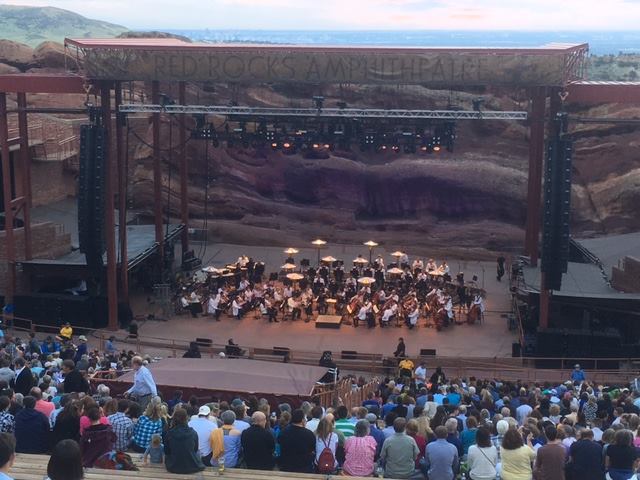 Red Rocks and the Colorado Symphony
Red Rocks and the Colorado Symphony
Our last day included a delightful hike off of Highway 285 near
Grant. These were the best columbine specimen we had seen on the trip and the gurgling river and
unusual rock formations made this high altitude hike special. We had driven east from the Black
Canyon of the Gunnison through the small town of Gunnison before climbing up in altitude again. We
cut our hike a bit short to allow ourselves plenty of time to arrive at Red Rocks and have a quick
dinner in the RV before walking for at least a mile up and up to this acclaimed natural amphitheater
owned by the City of Denver. The lighting on the red surfaces were phenomenal as was the acoustics.
The Colorado Symphony played Mozart's last symphony called Jupiter and also a more modern piece, The
Planets—Gustav Holst's musical exploration into the astrological influence of the planets. I was
able to move down from the seats I bought and stretch out on the wooden benches. It was a welcome
all sensory spectacle with swirling backdrops of different colors and shapes, haunting classical
music and the stars above to ponder. A fitting ending to the exploration of the wonders of Colorado.
| |



 Karen's Perspective on Traveling
Alone
Karen's Perspective on Traveling
Alone


 Karen's Perspective on Traveling
Alone
Karen's Perspective on Traveling
Alone